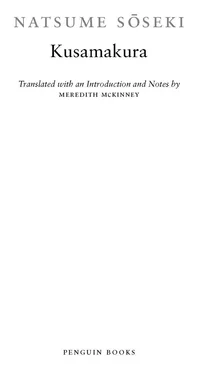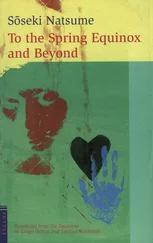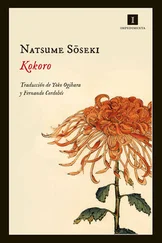Natsume Soseki - Kusamakura
Здесь есть возможность читать онлайн «Natsume Soseki - Kusamakura» весь текст электронной книги совершенно бесплатно (целиком полную версию без сокращений). В некоторых случаях можно слушать аудио, скачать через торрент в формате fb2 и присутствует краткое содержание. Жанр: Старинная литература, на английском языке. Описание произведения, (предисловие) а так же отзывы посетителей доступны на портале библиотеки ЛибКат.
- Название:Kusamakura
- Автор:
- Жанр:
- Год:неизвестен
- ISBN:нет данных
- Рейтинг книги:4 / 5. Голосов: 1
-
Избранное:Добавить в избранное
- Отзывы:
-
Ваша оценка:
- 80
- 1
- 2
- 3
- 4
- 5
Kusamakura: краткое содержание, описание и аннотация
Предлагаем к чтению аннотацию, описание, краткое содержание или предисловие (зависит от того, что написал сам автор книги «Kusamakura»). Если вы не нашли необходимую информацию о книге — напишите в комментариях, мы постараемся отыскать её.
Kusamakura — читать онлайн бесплатно полную книгу (весь текст) целиком
Ниже представлен текст книги, разбитый по страницам. Система сохранения места последней прочитанной страницы, позволяет с удобством читать онлайн бесплатно книгу «Kusamakura», без необходимости каждый раз заново искать на чём Вы остановились. Поставьте закладку, и сможете в любой момент перейти на страницу, на которой закончили чтение.
Интервал:
Закладка:
The warm steam that is inundating the room continues to pour forth even though the room is already flooded with it to ful ness. In the spring evening, the room’s light is shattered and diffused into semitransparency, al asway in a world of dense rainbows, and from these cloudy depths, hazily, the pale figure gradual y swims into view. Even the blackness of her hair is softened to the point of obscurity. Look at the contours of that shape!
A line begins lightly and modestly at the nape of the neck, then draws in from both sides to slide easily down and over the shoulders, breaks into ample curves that flow on down the arms til they no doubt final y part ways at the fingers. Beneath the ful swel ing breasts, the waves of line recede momentarily, to swel smoothly out again in the gentle curve of her abdomen. The line of force then slips around behind the form, and where the tension of the line gives out, the two columns of flesh tend slightly forward to balance it. The knees now receive the lines and reverse them, and when those long undulations have traveled to the heels, the flat plane of the feet brings al this intricacy to rest in effortless completion at the soles.
The world could hold no more complex tension of forces, and none more unified. One could discover no contours more natural, more soft and unresisting, less troubling than these.
Moreover, this shape is not thrust blatantly before my eyes, revealed like a common nude. The perfection of its beauty is only modestly intimated, hinted in an ethereal atmosphere in which al is transformed to profound subtlety. Like some apparition of a mythic dragon suggested to the imagination’s eye by a few brief flecks of scale within a brushstroke wash, the shape is replete with a subtle air, a warmth, an unfathomable depth that satisfies every instinct of the artistic sensibility. If minutely depicting every scale on a dragon becomes ludicrous, then equivalently, veiling a naked figure from ful and flagrant exposure to the eye resonates with a hidden profundity. Gazing upon this form, my eyes seem to be beholding some faery moon maiden, fled from her lunar realm, hesitating a moment before me as the pursuing rainbows swarm about her.
The white form grows increasingly distinct. Another step, and this delightful moon maiden may, alas, descend into the common world—but just as the thought crosses my mind, her jet-black hair swirls suddenly like the tail of the mythic turtle that cleaves the waves, starting a sinuous undulation rippling along its length, and up the stairs the white figure leaps, rending the swirling veils of steam as it goes. A woman’s clear peal of laughter echoes away down the corridor; in its wake, the bathroom fal s quiet.
I gulp in a mouthful of hot water and stand stock-stil in the bathtub, while startled waves lap at my chest, spil ing with a soft whoosh over the tub’s edge.
CHAPTER 8
I take tea with the master of the house, Mr. Shioda. The other guests present are the abbot of Kankaiji temple, who introduces himself as Daitetsu, and a layman, a young man of twenty-four or -five.
Taking a right turn along the corridor from my door and then a left at the end has led me to the old gentleman’s room, which is down at the far end. The room is a six-mat one, about twelve feet by nine, and a large, low sandalwood table occupies the center, imparting an unexpectedly cramped feeling to the space. Instead of the usual cushions surrounding it, there’s a carpet with a woven flower design. It is no doubt Chinese.
In its center is a hexagon containing a scene depicting a rather strange house and an odd wil ow. The surrounding ground is an almost steel-blue indigo, and at each corner is a brown circle, through which is woven an arabesque design. I doubt that such a thing would actual y be found in a Chinese sitting room, but it is certainly most intriguing here, in place of the normal cushions. Just as the worth of an Indian cotton print or a Persian wal hanging lies in its slight oddness, so this flowered carpet’s generosity and lack of fuss constitute its tastefulness. Al such Chinese household furnishings, indeed, have the same rather dul and unimaginative quality. One is forced to the conclusion that they’re the inventions of a race of patient and slightly slowwitted people. The special value of these objects is the way they daze and bemuse the viewer. Japan’s works of art, on the other hand, are created with al a pickpocket’s fine-tuned alertness. The West creates on a grand and detailed scale, which can never quite free itself of the reek of worldliness.
Such are the thoughts in my head as I take my seat. The young man places himself beside me, halfway down the length of the carpet.
The abbot is seated on a tiger skin, whose tail spreads past my knees while the head lies beneath the old gentleman. Al the gentleman’s hair seems to have been removed and transplanted onto his face, so that his cheeks and chin are smothered in a thick tangle of white beard. He is careful y arranging the teacups on their little saucers on the table before him.
“We have an unaccustomed guest staying, so I thought I’d take the opportunity of asking you to tea,†he says, turning to the abbot.
“Thank you for sending someone along to invite me. I haven’t gotten around to visiting for quite some time, and I was just thinking I must cal in today.†The abbot is close to sixty, with a round face and softened features reminiscent of one of those quick, freehand ink sketches of the Bodhidharma. He seems on familiar terms with the old gentleman. “This is your guest, I presume?â€
The old gentleman nods as he lifts the little red clay teapot and lets the precious greenish-amber liquid trickle two or three drops at a time into the teacups. I am pleasantly aware of its elegant aroma gently invading my nostrils.
The abbot speaks to me immediately. “You must be feeling lonely here in the countryside by yourself.â€
“Er, wel . . .†I say, unable to summon any real answer. If I say I’m lonely, it wil be a lie, but if I say I’m not, a long explanation wil be required.
“Not so, Your Reverence,†our host chimes in. “This gentleman’s come here to paint, so he’s quite busy in fact.â€
“Ah, is that so? That’s good. Would you be an artist in the Nanso School?â€1
“No,†I manage to reply this time. The abbot wouldn’t understand it if I told him I painted in the Western style, I decide.
“No, he’s in that Western style,†the old gentleman says, coming to my aid once more in his role as host.
“Ah, Western, eh? That’s the sort of thing Kyuichi does, isn’t it? I saw his work for the first time the other day. Very nicely done, I thought.â€
“No no, they’re just boring little things,†the young man protests, breaking his silence.
“So you showed the abbot one of your poor pieces, did you?†the old man inquires. Judging from his attitude and the way he speaks to the young man, they’re probably related.
“I didn’t exactly request a viewing—he came across me when I was sketching at Mirror Pool,†says Kyuichi.
“Hm, is that so? . . . Wel now, the tea is poured. Do have some,†the old man says, placing a cup before each of us. There are no more than three or four drops of tea in each, though the cups themselves are very large. The glaze is a light gray ground, daubed al over with burnt sienna and pale yel ow brushstrokes that may have been intended as a painting or merely as a pattern, reminiscent of a half-formed devil’s face.
Читать дальшеИнтервал:
Закладка:
Похожие книги на «Kusamakura»
Представляем Вашему вниманию похожие книги на «Kusamakura» списком для выбора. Мы отобрали схожую по названию и смыслу литературу в надежде предоставить читателям больше вариантов отыскать новые, интересные, ещё непрочитанные произведения.
Обсуждение, отзывы о книге «Kusamakura» и просто собственные мнения читателей. Оставьте ваши комментарии, напишите, что Вы думаете о произведении, его смысле или главных героях. Укажите что конкретно понравилось, а что нет, и почему Вы так считаете.












